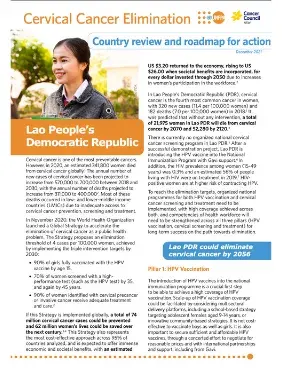Cervical cancer is one of the most preventable cancers. However, in 2020, an estimated 341,800 women died from cervical cancer globally. The annual number of new cases of cervical cancer has been projected to increase from 570,000 to 700,000 between 2018 and 2030, with the annual number of deaths projected to increase from 311,000 to 400,000. Most of these deaths occurred in low- and lower-middle income countries (LMICs) due to inadequate access to cervical cancer prevention, screening and treatment.
In November 2020, the World Health Organization launched a Global Strategy to accelerate the elimination of cervical cancer as a public health problem. The Strategy proposes an elimination threshold of 4 cases per 100,000 women, achieved by implementing the triple intervention targets by 2030:
90% of girls fully vaccinated with the HPV vaccine by age 15.
70% of women screened with a high- performance test (such as the HPV test) by 35, and again by 45 years.
90% of women identified with cervical precancer or invasive cancer receive adequate treatment and care.
If this Strategy is implemented globally, a total of 74 million cervical cancer cases could be prevented and 62 million women’s lives could be saved over the next century. This Strategy also represents
the most cost-effective approach across 95% of countries analyzed, and is expected to offer immense economic and societal benefits, with an estimated US $3.20 returned to the economy, rising to US $26.00 when societal benefits are incorporated, for every dollar invested through 2050 due to increases in women’s participation in the workforce.
In Lao People’s Democratic Republic (PDR), cervical cancer is the fourth most common cancer in women, with 320 new cases (11.4 per 100,000 women) and 182 deaths (7.0 per 100,000 women) in 2018. It was predicted that without any intervention, a total of 21,975 women in Lao PDR will die from cervical cancer by 2070 and 52,280 by 2120.
There is currently no organized national cervical cancer screening program in Lao PDR. After a successful demonstration project, Lao PDR is introducing the HPV vaccine into the National Immunization Program with Gavi support. In addition, the HIV prevalence among women (15-49 years) was 0.3% and an estimated 56% of people living with HIV were on treatment in 2019. HIV- positive women are at higher risk of contracting HPV.
To reach the elimination targets, organized national programmes for both HPV vaccination and cervical cancer screening and treatment need to be implemented, with high coverage achieved across both, and competencies of health workforce will need to be strengthened across all three pillars (HPV vaccination, cervical screening and treatment) for long-term success on the path towards elimination.


